- Calendar
- Online Ticket Sales
- Access
- JA
- EN
Treasures from the Chishakuin Temple in Kyoto
November 30, 2022 to January 22, 2023
*Download the list of changes in works on display
*There will be an exhibition change during the course of exhibition.
*The period is subject to change.
The list of changes in worksPDF
*The order of chapters may change at the exhibition venue
Chapter 1—From Kūkai to Chishakuin Temple
Shingon Buddhism was established by Kōbō Daishi (Kūkai). During the Heian period, at the start of the 9th century, Kūkai founded a temple complex on Mount Kōya in Kii province (present-day Wakayama prefecture) to serve as the central temple of Shingon Esoteric Buddhism. The complex later declined, but it was revived by Kōgyō Daishi (Kakuban) and he established Daidenbō-in Temple on Mount Kōya in 1130 on the orders of the Cloistered Emperor Toba (1103–56), a convert to Buddhism. The priest Raiyu sōjō (1226–1304) studied at Daidenbō-in and he later relocated the temple to Buhuku-ji (the predecessor to Negoroji), a temple at the foot of Mount Kōya that the Cloistered Emperor Toba had granted to Kakuban, with Kūkai’s traditions also inherited by Chishakuin.
This chapter examines the history of Chishakuin and its transmission of Kūkai’s teachings. It does so through magnificent portraits of the Shingon founders and precious items connected to the scholar-priests who revived Chishakuin. It also introduces the background to the formation of Chishakuin’s treasure collection through Record of Sacred Treasures, Surplices, Furniture and Household Goods at Chishakuin Temple (hereinafter ‘Record’) and other valuable documents never before shown outside the temple’s walls.
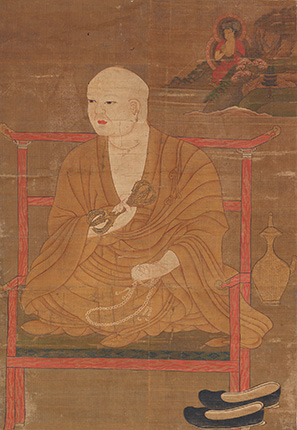
Hanging scroll, Muromachi period, dated 1444
Chishakuin Temple
【On display between Nov. 30 and Dec. 26】
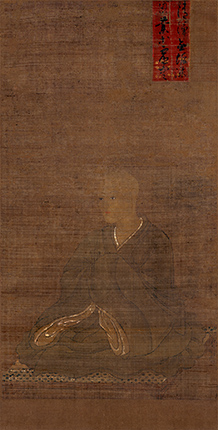
Hanging scroll, Kamakura period, 13th century
Chishakuin Temple
【On display between Nov. 30 and Dec. 26】
Chapter 2—The Quintessence of Momoyama Art: The Tōhaku School Wall Paintings
In 1591, Toyotomi Hideyoshi began building Shōunzen-ji Temple in Higashiyama, Kyoto to memorialize his son Tsurumatsu (Sutemaru), who had died aged three. It is believed the construction was completed in 1593, the third year since Tsurumatsu’s passing, with the polychrome-and-gold wall paintings by Hasegawa Tōhaku’s school also apparently completed at the same time. Later, the Tokugawa administration granted Shōunzen-ji’s buildings and wall paintings to Chishakuin, with the paintings subsequently protected by Chishakuin and passed down safely to the present day through fires, thefts and other disasters. Record and other documents recount how the wall paintings were later altered and modified, but the dynamic brushwork of Tōhaku and his son Kyūzō (1568–93) still shines through, with the resplendent brilliance and rich lyricism of Momoyama-period art on vivid display in the paintings.
This chapter presents a valuable opportunity to fully appreciate Chishakuin’s treasured wall paintings, with Maple Tree and Cherry Blossom Tree displayed together outside Chishakuin for the first time and Tōhaku’s masterwork Pine Tree and Sunset Hibiscuses also making its first public appearance outside the temple’s walls.

Hasegawa Tōhaku
Four of six panels, Momoyama period, 16th century
Chishakuin Temple
【To be shown over an entire period】

Hasegawa Kyūzō
Four of five panels, Momoyama period, 16th century
Chishakuin Temple
【To be shown over an entire period】
Chapter 3—The Buddhist Art of Gakusan Chisan
The academic traditions of Shingon Buddhism were passed down from Kūkai and faithfully transmitted to the present day through Chishakuin. Also known as Gakusan Chisan, the temple has produced many renowned scholar-priests and it has long served as an academic hub connecting scholars from across Japan. This rich history is on vivid display in Chishakuin’s treasures, which include Buddhist art from a wide range of other schools in addition to Shingon Buddhism.
One prime example is the National Treasure Kongō kyō (Diamond Sutra), a representative work by the Southern Song dynasty calligrapher Zhang Jizhi (1186–1266). Characterized by its stately brushwork, this work had a major influence on Japanese calligraphy. Also noteworthy are the Important Cultural Properties Dōji kyō Mandala (Mandala of a Ritual for Children) and Kujaku Myōō (Mahamayuri Vidyaraja). These richly-colored masterpieces of Kamakura-period art occupy an important place in the history of Buddhist painting.
This chapter also introduces magnificent Buddhist paintings, mandalas and sutras that have imbued Chishakuin’s halls with a sense of solemnity during Buddhist rituals.
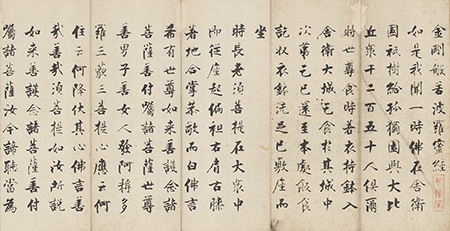
Zhang Jizhi
Album, Southern Song dynasty, dated 1253
Chishakuin Temple
【To be shown over an entire period】
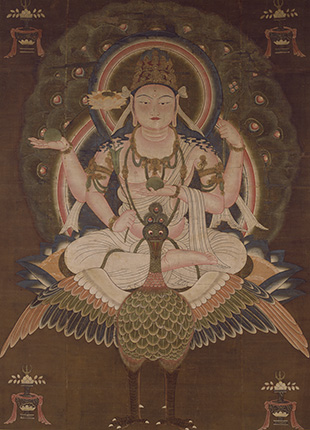
Hanging scroll, Kamakura period, 14th century
Chishakuin Temple
【On display between Dec. 28 and Jan. 22】
Chapter 4—Chishakuin and the Art Collected from East Asia
Record lists the names of people who donated treasures to Chishakuin. These include successive head priests as well as powerful laypeople with connections to the Tokugawa shogunate, a fact that testifies to the close relations between the temple and the shogunate.
The Important Cultural Property Waterfall is a masterpiece of Southern Song dynasty art donated by the 10th head priest Senkai sōjō (1640–1710). This work captivates with the way the waterfall and waves are artfully depicted using different shades of black ink. A further highlight is Kannon on Lotus Petal, a painting the 5th shogun Tokugawa Tsunayoshi (1646–1709) apparently gifted to Chishakuin’s 8th head priest Shinzei sōjō (1620–93). This work demonstrates the masterful techniques Tsunayoshi acquired under the Kanō school of painters. Also noteworthy is Hanabusa Itchō’s (1652–1724) Mount Fuji Viewed From Busan Bay, which was donated by Makino Hideshige (1671–1741), the 15th Kyoto Shoshidai (the shogunate’s representative in Kyoto). The painting provides a vivid example of the Edo Kanō style studied by Itchō. This chapter showcases some of the diverse works in Chishakuin’s collection, from Chinese and other art to masterpieces of early modern Japanese painting.
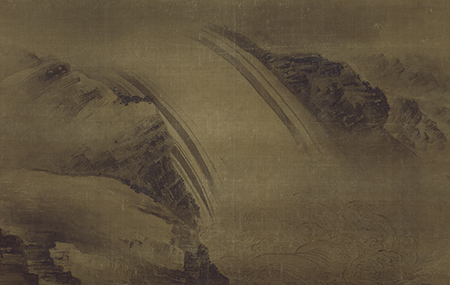
Hanging scroll, Southern Song dynasty, 13th century
Chishakuin Temple
【On display between Nov. 30 and Dec. 26】
Chapter 5—The Modern Artworks Inspired by Chishakuin’s Treasures
The Kyoto painter Tsuchida Bakusen (1887–1936) had a deep connection with Chishakuin. He entered the temple at age sixteen, though he later ran away to become a painter. However, his artistic studies at Chishakuin continued to influence his work. The lyricism and decorativeness of Chishakuin’s Maple Tree and Cherry Blossom Tree are on full display in Bakusen’s Morning Glories, for example.
Another major figure in the Kyoto art world was Dōmoto Inshō (1891–1975). Chishakuin’s Shinden hall is decorated with several works by Dōmoto, including two he painted at age 67: Ladies Having Tea and Pine, Cherry Blossom and Willow Trees. With their modern compositions, vivid coloring on gold leaf, and bold, vigorous tree depictions, these sliding door paintings are strongly reminiscent of Chishakuin’s Hasegawa-school wall paintings.
This chapter features rarely-shown works by two great artists with deep ties to Chishakuin. It also introduces fine decorative art objects associated with the temple. In doing so, it traces the appeal of these modern artworks that resonate so powerfully with Chishakuin’s ancient treasures.
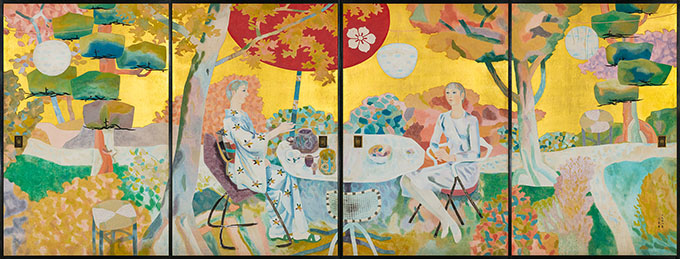
Dōmoto Inshō
Four panels, Shōwa era, dated 1958
Chishakuin Temple
【To be shown over an entire period】
*Unauthorized reproduction or use of texts or images from this site is prohibited.
2025 January
- Exhibition
- Closed
- Tea Ceremony
- Mon
- Tue
- Wed
- Thu
- Fri
- Sat
- Sun
- 1
- 2
- 3
- 4
- 5
- 6
- 7
- 8
- 9
- 10
- 11
- 12
- 13
- 14
- 15
- 16
- 17
- 18
- 19
- 20
- 21
- 22
- 23
- 24
- 25
- 26
- 27
- 28
- 29
- 30
- 31
2025 February
- Exhibition
- Closed
- Tea Ceremony
- Mon
- Tue
- Wed
- Thu
- Fri
- Sat
- Sun
- 1
- 2
- 3
- 4
- 5
- 6
- 7
- 8
- 9
- 10
- 11
- 12
- 13
- 14
- 15
- 16
- 17
- 18
- 19
- 20
- 21
- 22
- 23
- 24
- 25
- 26
- 27
- 28
2025 March
- Exhibition
- Closed
- Tea Ceremony
- Mon
- Tue
- Wed
- Thu
- Fri
- Sat
- Sun
- 1
- 2
- 3
- 4
- 5
- 6
- 7
- 8
- 9
- 10
- 11
- 12
- 13
- 14
- 15
- 16
- 17
- 18
- 19
- 20
- 21
- 22
- 23
- 24
- 25
- 26
- 27
- 28
- 29
- 30
- 31
2025 April
- Exhibition
- Closed
- Tea Ceremony
- Mon
- Tue
- Wed
- Thu
- Fri
- Sat
- Sun
- 1
- 2
- 3
- 4
- 5
- 6
- 7
- 8
- 9
- 10
- 11
- 12
- 13
- 14
- 15
- 16
- 17
- 18
- 19
- 20
- 21
- 22
- 23
- 24
- 25
- 26
- 27
- 28
- 29
- 30
2025 May
- Exhibition
- Closed
- Tea Ceremony
- Mon
- Tue
- Wed
- Thu
- Fri
- Sat
- Sun
- 1
- 2
- 3
- 4
- 5
- 6
- 7
- 8
- 9
- 10
- 11
- 12
- 13
- 14
- 15
- 16
- 17
- 18
- 19
- 20
- 21
- 22
- 23
- 24
- 25
- 26
- 27
- 28
- 29
- 30
- 31
2025 June
- Exhibition
- Closed
- Tea Ceremony
- Mon
- Tue
- Wed
- Thu
- Fri
- Sat
- Sun
- 1
- 2
- 3
- 4
- 5
- 6
- 7
- 8
- 9
- 10
- 11
- 12
- 13
- 14
- 15
- 16
- 17
- 18
- 19
- 20
- 21
- 22
- 23
- 24
- 25
- 26
- 27
- 28
- 29
- 30
2025 July
- Exhibition
- Closed
- Tea Ceremony
- Mon
- Tue
- Wed
- Thu
- Fri
- Sat
- Sun
- 1
- 2
- 3
- 4
- 5
- 6
- 7
- 8
- 9
- 10
- 11
- 12
- 13
- 14
- 15
- 16
- 17
- 18
- 19
- 20
- 21
- 22
- 23
- 24
- 25
- 26
- 27
- 28
- 29
- 30
- 31
2025 August
- Exhibition
- Closed
- Tea Ceremony
- Mon
- Tue
- Wed
- Thu
- Fri
- Sat
- Sun
- 1
- 2
- 3
- 4
- 5
- 6
- 7
- 8
- 9
- 10
- 11
- 12
- 13
- 14
- 15
- 16
- 17
- 18
- 19
- 20
- 21
- 22
- 23
- 24
- 25
- 26
- 27
- 28
- 29
- 30
- 31
2025 September
- Exhibition
- Closed
- Tea Ceremony
- Mon
- Tue
- Wed
- Thu
- Fri
- Sat
- Sun
- 1
- 2
- 3
- 4
- 5
- 6
- 7
- 8
- 9
- 10
- 11
- 12
- 13
- 14
- 15
- 16
- 17
- 18
- 19
- 20
- 21
- 22
- 23
- 24
- 25
- 26
- 27
- 28
- 29
- 30
2025 October
- Exhibition
- Closed
- Tea Ceremony
- Mon
- Tue
- Wed
- Thu
- Fri
- Sat
- Sun
- 1
- 2
- 3
- 4
- 5
- 6
- 7
- 8
- 9
- 10
- 11
- 12
- 13
- 14
- 15
- 16
- 17
- 18
- 19
- 20
- 21
- 22
- 23
- 24
- 25
- 26
- 27
- 28
- 29
- 30
- 31
2025 November
- Exhibition
- Closed
- Tea Ceremony
- Mon
- Tue
- Wed
- Thu
- Fri
- Sat
- Sun
- 1
- 2
- 3
- 4
- 5
- 6
- 7
- 8
- 9
- 10
- 11
- 12
- 13
- 14
- 15
- 16
- 17
- 18
- 19
- 20
- 21
- 22
- 23
- 24
- 25
- 26
- 27
- 28
- 29
- 30
2025 December
- Exhibition
- Closed
- Tea Ceremony
- Mon
- Tue
- Wed
- Thu
- Fri
- Sat
- Sun
- 1
- 2
- 3
- 4
- 5
- 6
- 7
- 8
- 9
- 10
- 11
- 12
- 13
- 14
- 15
- 16
- 17
- 18
- 19
- 20
- 21
- 22
- 23
- 24
- 25
- 26
- 27
- 28
- 29
- 30
- 31
2026 January
- Exhibition
- Closed
- Tea Ceremony
- Mon
- Tue
- Wed
- Thu
- Fri
- Sat
- Sun
- 1
- 2
- 3
- 4
- 5
- 6
- 7
- 8
- 9
- 10
- 11
- 12
- 13
- 14
- 15
- 16
- 17
- 18
- 19
- 20
- 21
- 22
- 23
- 24
- 25
- 26
- 27
- 28
- 29
- 30
- 31
2026 February
- Exhibition
- Closed
- Mon
- Tue
- Wed
- Thu
- Fri
- Sat
- Sun
- 1
- 2
- 3
- 4
- 5
- 6
- 7
- 8
- 9
- 10
- 11
- 12
- 13
- 14
- 15
- 16
- 17
- 18
- 19
- 20
- 21
- 22
- 23
- 24
- 25
- 26
- 27
- 28
2026 March
- Exhibition
- Closed
- Mon
- Tue
- Wed
- Thu
- Fri
- Sat
- Sun
- 1
- 2
- 3
- 4
- 5
- 6
- 7
- 8
- 9
- 10
- 11
- 12
- 13
- 14
- 15
- 16
- 17
- 18
- 19
- 20
- 21
- 22
- 23
- 24
- 25
- 26
- 27
- 28
- 29
- 30
- 31
2026 April
- Exhibition
- Closed
- Mon
- Tue
- Wed
- Thu
- Fri
- Sat
- Sun
- 1
- 2
- 3
- 4
- 5
- 6
- 7
- 8
- 9
- 10
- 11
- 12
- 13
- 14
- 15
- 16
- 17
- 18
- 19
- 20
- 21
- 22
- 23
- 24
- 25
- 26
- 27
- 28
- 29
- 30
2026 May
- Exhibition
- Closed
- Mon
- Tue
- Wed
- Thu
- Fri
- Sat
- Sun
- 1
- 2
- 3
- 4
- 5
- 6
- 7
- 8
- 9
- 10
- 11
- 12
- 13
- 14
- 15
- 16
- 17
- 18
- 19
- 20
- 21
- 22
- 23
- 24
- 25
- 26
- 27
- 28
- 29
- 30
- 31
2026 June
- Exhibition
- Closed
- Mon
- Tue
- Wed
- Thu
- Fri
- Sat
- Sun
- 1
- 2
- 3
- 4
- 5
- 6
- 7
- 8
- 9
- 10
- 11
- 12
- 13
- 14
- 15
- 16
- 17
- 18
- 19
- 20
- 21
- 22
- 23
- 24
- 25
- 26
- 27
- 28
- 29
- 30
2026 July
- Exhibition
- Closed
- Mon
- Tue
- Wed
- Thu
- Fri
- Sat
- Sun
- 1
- 2
- 3
- 4
- 5
- 6
- 7
- 8
- 9
- 10
- 11
- 12
- 13
- 14
- 15
- 16
- 17
- 18
- 19
- 20
- 21
- 22
- 23
- 24
- 25
- 26
- 27
- 28
- 29
- 30
- 31
2026 August
- Exhibition
- Closed
- Mon
- Tue
- Wed
- Thu
- Fri
- Sat
- Sun
- 1
- 2
- 3
- 4
- 5
- 6
- 7
- 8
- 9
- 10
- 11
- 12
- 13
- 14
- 15
- 16
- 17
- 18
- 19
- 20
- 21
- 22
- 23
- 24
- 25
- 26
- 27
- 28
- 29
- 30
- 31
2026 September
- Exhibition
- Closed
- Mon
- Tue
- Wed
- Thu
- Fri
- Sat
- Sun
- 1
- 2
- 3
- 4
- 5
- 6
- 7
- 8
- 9
- 10
- 11
- 12
- 13
- 14
- 15
- 16
- 17
- 18
- 19
- 20
- 21
- 22
- 23
- 24
- 25
- 26
- 27
- 28
- 29
- 30
2026 October
- Exhibition
- Closed
- Mon
- Tue
- Wed
- Thu
- Fri
- Sat
- Sun
- 1
- 2
- 3
- 4
- 5
- 6
- 7
- 8
- 9
- 10
- 11
- 12
- 13
- 14
- 15
- 16
- 17
- 18
- 19
- 20
- 21
- 22
- 23
- 24
- 25
- 26
- 27
- 28
- 29
- 30
- 31
2026 November
- Exhibition
- Closed
- Mon
- Tue
- Wed
- Thu
- Fri
- Sat
- Sun
- 1
- 2
- 3
- 4
- 5
- 6
- 7
- 8
- 9
- 10
- 11
- 12
- 13
- 14
- 15
- 16
- 17
- 18
- 19
- 20
- 21
- 22
- 23
- 24
- 25
- 26
- 27
- 28
- 29
- 30
2026 December
- Exhibition
- Closed
- Mon
- Tue
- Wed
- Thu
- Fri
- Sat
- Sun
- 1
- 2
- 3
- 4
- 5
- 6
- 7
- 8
- 9
- 10
- 11
- 12
- 13
- 14
- 15
- 16
- 17
- 18
- 19
- 20
- 21
- 22
- 23
- 24
- 25
- 26
- 27
- 28
- 29
- 30
- 31
